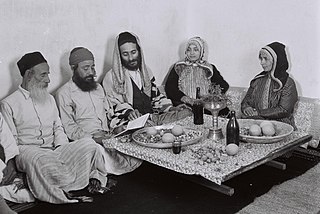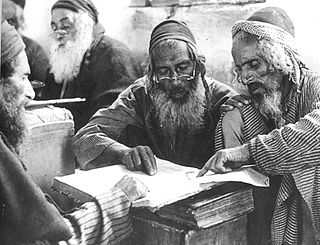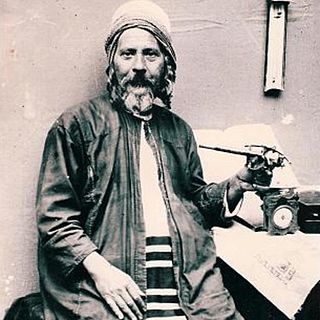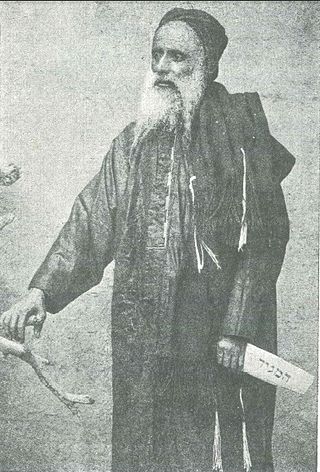
A siddur is a Jewish prayer book containing a set order of daily prayers. The word siddur comes from the Hebrew root ס־ד־ר, meaning 'order.'

Saʿadia ben Yosef Gaon was a prominent rabbi, gaon, Jewish philosopher, and exegete who was active in the Abbasid Caliphate.

Yemenite Jews, also known as Yemeni Jews or Teimanim, are Jews who live, or once lived, in Yemen, and their descendants maintaining their customs. Between June 1949 and September 1950, the overwhelming majority of the country's Jewish population emigrated to Israel in Operation Magic Carpet. After several waves of persecution, the vast majority of Yemenite Jews now live in Israel, while smaller communities live in the United States and elsewhere. As of 2024, only five Jews remained in Yemen, with one of them being Levi Marhabi.

Yemenite Hebrew, also referred to as Temani Hebrew, is the pronunciation system for Hebrew traditionally used by Yemenite Jews. Yemenite Hebrew has been studied by language scholars, many of whom believe it retains older phonetic and grammatical features lost elsewhere. Yemenite speakers of Hebrew have garnered considerable praise from language purists because of their use of grammatical features from classical Hebrew.

Yosef Qafiḥ, widely known as Rabbi Yosef Kapach, was a Yemenite-Israeli authority on Jewish religious law (halakha), a dayan of the Supreme Rabbinical Court in Israel, and one of the foremost leaders of the Yemenite Jewish community in Israel, where he was sought after by non-Yemenites as well. He is widely known for his editions and translations of the works of Maimonides, Saadia Gaon, and other early rabbinic authorities (Rishonim), particularly his restoration of the Mishneh Torah from old Yemenite manuscripts and his accompanying commentary culled from close to 300 additional commentators and with original insights. He was the grandson of Rabbi Yiḥyah Qafiḥ, a prominent Yemenite leader and founder of the Dor Deah movement in Yemen. Qafih was the recipient of many awards, as well as an Honorary Doctorate from Bar-Ilan University.

Yiḥyah Qafiḥ (1850–1931), known also as "Ha-Yashish", served as the Chief Rabbi of Sana'a, Yemen in the late nineteenth and early twentieth centuries. He was one of the foremost rabbinical scholars in Sana'a during that period, and an advocate of reforms in Jewish education. He was also learned in astronomy, and rabbinic astrology and Jewish classical literature.

Midrash HaGadol or The Great Midrash is a work of aggaddic midrash, expanding on the narratives of the Torah, which was written by David ben Amram Adani of Yemen.

Adeni Jews, or Adenite Jews are the historical Jewish community which resided in the port city of Aden. Adenite culture became distinct from other Yemenite Jewish culture due to British control of the city and Indo-Iraqi Jewish influence as well as recent arrivals from Persia and Egypt. Although they were separated, Adeni Jews depended on the greater Yemenite community for spiritual guidance, receiving their authorizations from Yemeni rabbis. Virtually the entire population emigrated from Aden between June 1947 and September 1967. As of 2004, there were 6,000 Adenites in Israel, and 1,500 in London.

Rabbi Hayyim Habshush was a coppersmith by trade, and a noted nineteenth-century historiographer of Yemenite Jewry. He also served as a guide for the Jewish-French Orientalist and traveler Joseph Halévy. After his journey with Halévy in 1870, he was employed by Eduard Glaser and other later travellers to copy inscriptions and to collect old books.
The Orphans' Decree was a law in the Kingdom of Yemen mandating the forced conversion of Jewish orphans to Islam promulgated by the Zaydi. According to one source, the decree has "no parallel in other countries".
Zechariah (Yaḥya) al-Ḍāhirī, often spelled Zechariah al-Dhahiri, was the son of Saʻīd (Saʻadia) al-Ḍāhirī, from Kawkaban, in the District of al-Mahwit, Yemen, a place north-west of Sana’a. He is recognized as one of the most gifted Yemenite Jewish poets and rabbinic scholars who left South Arabia in search of a better livelihood, travelling to the Zamorin-ruled Calicut and Cochin in the Indian subcontinent, Hormuz in Safavid Iran, Ottoman-ruled Basra and Irbil in Ottoman Iraq, Bursa and Istanbul in Ottoman Anatolia, Rome in Italy, Aleppo, Damascus, Safed, Tiberias, Jerusalem, and Hebron in Ottoman Syria, Sidon in the Damascus Eyalet, and the Egypt Eyalet, and finally to the Adal Sultanate in Ethiopia, where he returned to Yemen by crossing the Red Sea and alighting at a port city near Mocha. He wrote extensively about his travels and experiences in these places, which he penned in a Hebrew-language rhymed prose narrative, eventually publishing them in a book which he called Sefer HaMusar, in circa 1580.

The Mawza Exile is considered the single most traumatic event experienced collectively by the Jews of Yemen, in which Jews living in nearly all cities and towns throughout Yemen were banished by decree of the king, Imām al-Mahdi Ahmad, and sent to a dry and barren region of the country named Mawzaʻ to withstand their fate or to die. Only a few communities, viz., those Jewish inhabitants who lived in the far eastern quarters of Yemen were spared this fate by virtue of their Arab patrons who refused to obey the king's orders. Many would die along the route and while confined to the hot and arid conditions of this forbidding terrain. After one year in exile, the exiles were called back to perform their usual tasks and labors for the indigenous Arab populations, who had been deprived of goods and services on account of their exile.
The Baladi-rite Prayer is the oldest known prayer-rite used by Yemenite Jews, transcribed in a prayer book known as a tiklāl in Yemenite Jewish parlance. "Baladi", as a term applied to the prayer-rite, was not used until prayer books arrived in Yemen in the Sephardic-rite.

Yiḥya Yitzḥak Halevi, son of Moshe (Musa) Yitzḥak Halevi, was a Yemeni born rabbinical scholar who served as one of the last great scholars and chief jurists of the rabbinic court at Ṣan‘ā’, which post he held for nearly thirty years, a time interrupted only during the siege laid to the city by loyal Yemeni forces under Imām Yaḥyā Ḥamīd ad-Dīn (1904—1948) in their bid to oust the Ottoman Turks who then controlled the city. The Rabbi, meanwhile, had fled with his family to Dhamar.

Avraham Al-Naddaf (1866–1940), the son of Ḥayim b. Salem Al-Naddaf, was a Yemenite rabbi and scholar who immigrated to Ottoman Palestine in 1891, eventually becoming one of the members of the Yemenite rabbinical court (Beit-Din) established in Jerusalem in 1908, and active in public affairs. His maternal grandfather was Rabbi Yiḥya Badiḥi (1803–1887), the renowned sage and author of the Questions & Responsa, Ḥen Ṭov, and a commentary on the laws of ritual slaughter of livestock, Leḥem Todah, who served as the head of Sanaa's largest seat of learning (yeshiva), held in the synagogue, Bayt Saleḥ, before he was forced to flee from Sana'a in 1846 on account of the tyrant, Abū-Zayid b. Ḥasan al-Miṣrī, who persecuted the Jews under the Imam Al-Mutawakkil Muhammad.
Yihye Bashiri, also spelt Yahya al-Bashiri, known by his pen-name Avner bar Ner ha-Sharoni, and by the acronym Maharib, was a Yemenite Rabbi, professional scrivener and sofer of the Masoretic Text whose works of Hebrew manuscripts now account for many now stored in public libraries across the globe, including the Jewish Theological Seminary of America, Cambridge University Library, the Russian State Library and the Hebrew Union College-Jewish Institute of Religion, et al. Rabbi Yiḥyah Salaḥ coined him the epithet, "the great scribe of the Law." A man of uncommon piety, he is also known for an act of intervention on behalf of his community in Yemen, which brought miraculous deliverance to the Jews of Sana'a when they stood in danger of annihilation by the king, on account of libel and slander brought against them.
Yemenite Jewish poetry, often referred to as "paraliturgical poetry" because of its religious nature, has been an integral part of Yemenite Jewish culture since time immemorial. The Jews of Yemen have preserved a well-defined singing arrangement which not only includes the very poetic creation itself, but also involves a vocal and dance performance, accompanied in certain villages outside Sana'a by drumming on an empty tin-can (tanakeh) or a copper tray. The Jews of Yemen, maintaining strict adherence to Talmudic and Maimonidean halakha, observed the gezeirah which prohibited playing musical instruments, and "instead of developing the playing of musical instruments, they perfected singing and rhythm." This arrangement was integrated into the walks of life familiar to the Jews of Yemen. The texts used in the arrangement were put down in writing and later included in separate song collections (dīwāns). The social strictures and norms in Yemenite Jewish culture provide for separate settings for men and for women, where the sexes are never mixed. Men’s song usually expressed the national aspirations of the Jewish people, and it was far removed from the singing associated with the Muslim environment, whereas folk songs of Jewish women were sung by rote memory and expressed the happiness and sorrows inherent in their daily life and was, as a rule, closer to that of Muslim women.
Amram Qorah was the last Chief Rabbi in Yemen, assuming this role in 1934, after the death of Rabbi Yihya al-Abyadh, Resh Methivta, and which role he held for approximately two years. He is the author of the book, Sa'arat Teman, published post-mortem by the author's son, a book that documents the history of the Jews of Yemen and their culture for a little over 250 years, from the Mawza exile to the mass-immigration of Yemenite Jews to Israel in the mid-20th century.
David ben Amram Adani was a Yemenite Jewish scholar renowned for his authorship of Midrash HaGadol, a collection of homiletical expositions drawn from ancient rabbinic sources. Adani is believed to have descended from a line of prominent Jewish leaders in Aden, as he is referred to in one ancient source as "David b. Amram, the nagid from the city of Aden." Nagid is a title borne by the leader of the Jewish community of Aden from the 12th century.












